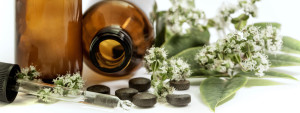
Herbal extracts have long been popular as an alternative medicine option as well as an important ingredient in the baking procedure. A wide array of these extracts are available in the market today, many of which go towards enhancing the health of the individual while others help in lending colour and flavour to your baked edibles.
Herbs are converted into extracts in order to increase their effectiveness. When used for medicinal purposes these extracts can be easily ingested as compared to the capsules made using the same herbal ingredients. To explain the making of the herbal extract in brief; fresh or dried herbal matter is firstly mashed or pulped and kept immersed in a solvent for a specific period of time. It can also be evaporated and concentrated. The mixture is then filtered and the extract which contains essentially all the elements of the herbs is obtained. The solvent could be either glycerine or alcohol or sometimes water. An extract can be made using a single herb but largely many herbs go in a specific combination to make a popular herbal extract. The extraction process requires careful detailing, highest levels of integrity and use of exclusive methods. In order to obtain maximum benefits from the herbal extract, it should be produced by using the cold process method of extraction. The packaging of the extract specifies the ratio of the solvent to the fresh herbs used to make the liquid concoction.
The various kinds of extracts available include single herbal extract, combination herbal extract, glycerite or the liquid herbal extract. Glycerites use vegetable glycerine as the solvent instead of alcohol while water is used in the making of the liquid herbal extract. For the single and combination herbal extract, alcohol remains the solvent. Sometimes, pure alcohol cannot be used for some extracts and hence certain amount of water needs to be added to the alcohol during their making. An alternative to using a solvent is the steam distillation process which gives herbal distillates. Herbal distillate is the residue obtained in the production of essential oils through this process and is popularly used in aroma-therapy. Specialty herbal extracts offer relief from a series of physical ailments such as hair loss, knee and joint pain, lower bowel disturbances etc.
A few of the liquid herbal extracts are naturally inclined to be cloudy due to the very nature of the herb or herbs used in its making. Even if they are set for a long period, clearness will not be obtained. Sometimes, some particles of the herb contained in the suspension may settle on the sides of the bottle. At the same time, the same herbal extract may differ slightly in taste from one year to the next. It is essential for a quality herbal extract to pass all the stringent measures set by the company before it is released for use. It is essential to purchase your herbal extract from a reputed company which is carrying on business for a long time. If the company has alternative non-compatible products such as acid dyes, leather dyes, it doesn’t really matter; as long as they conform to the standards set for the making of herbal extracts.